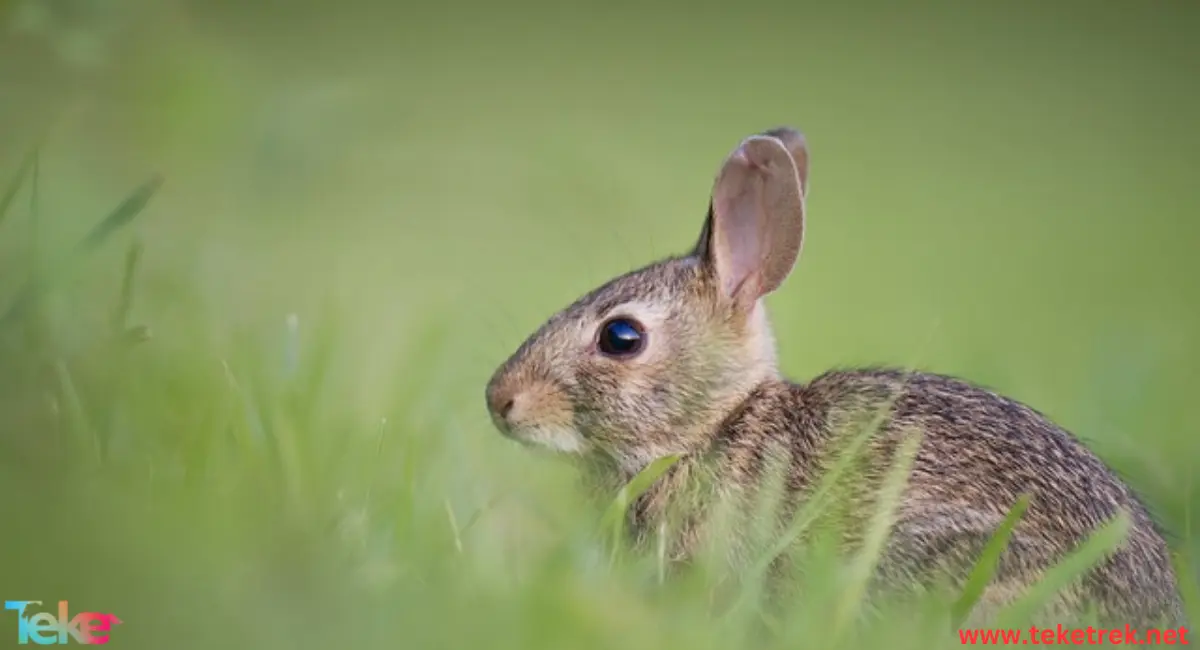Rabbits are gentle pets often seen under the care of someone in their home. Let’s learn more about them in this article on TekeTrek website: what they eat, their lifestyle, and how to take care of them when raising them.
Information about rabbits
- Rabbits are agile herbivorous mammals with short, ball-like tails. Rabbit scientific name is Oryctolagus cuniculus , Rabbit family is Leporidae.
- They have long ears, up to 10 inches, which allow them to hear predators from a long distance, giving them time to start running.
- Rabbits also possess long legs that help them jump quickly.
- They run in a zigzag pattern to confuse predators.
- Their eyes are designed for safety, allowing each eye to rotate nearly 360 degrees, enabling them to look behind without turning their heads.
- The female rabbit is called a doe, while the male is called a buck. Rabbits have many offspring called kits. Chicks are born blind and without fur. Rabbits can form their families at the age of 2 to 3 months.
Size of Rabbits
How do you describe a rabbit?
A rabbit is roughly the size of a cat, and some can grow to the size of a small child. Small rabbits reach 9.3 inches (24 cm) in length and weigh less than a pound, while larger species grow to 20 inches (50 cm) and weigh more than 10 pounds.
What Do Rabbits Eat?
- Rabbits are classified as herbivores, so they eat plants, including grass, leaves, broccoli, Brussels sprouts, fruit, seeds, and roots.
- Rabbits gather their food in the morning and evening to avoid being seen by predators such as owls, hawks, eagles, wild dogs, wild cats, and squirrels.
- It’s worth noting that rabbits cannot vomit, so they must be fed healthy food like vegetables and fruits.
- Rabbits do not live more than three years, and 90% of them die before they reach the age of one year, most of them in the first three months.

Origin and Habitat of Rabbits
- According to reports, the Romans originally brought rabbits in the first century. Rabbits are now widely spread across various parts of Britain and Ireland but are absent from Rome and the Isles of Scilly and some smaller islands.
- Rabbits are found anywhere they can dig, such as sand dunes, railway embankments, and urban areas.
- However, the most suitable areas for them are those where burrow zones and food supplies converge, such as forest edges and hedges.
Rabbit Lifestyle
- As mentioned, rabbits inhabit various environments worldwide, including forests, meadows, deserts, tundras, and wetlands.
- Female rabbits dig burrows in the ground to create nests for their offspring. These burrows have multiple entrances, allowing them to escape quickly. Some tunnels can reach depths of up to ten feet, depending on soil conditions and groundwater levels. The intricate network of tunnels, burrows, and bolt holes is collectively known as a “warren.” A large warren indicates a significant rabbit population.
- TThe Rabbit active in the morning and evening times. They forage for food and enjoy playing with other rabbits, as well as digging additional tunnels for their homes.
- During both day and night, rabbits remain safely in their burrows to avoid predators. They prefer to rest or relax during this time until they emerge above ground again.
- Rabbits live in social groups with other rabbits. These social groups vary in size, ranging from pairs to as many as thirty rabbits sharing the same warren.
Reproduction in Rabbits
- The rabbit breeding season primarily occurs from January to August. They produce 3 to 7 offspring per month. The female rabbit (doe) constructs a nest inside her burrow using grass and lines it with soft fur from her chest and abdomen.
- Newborn rabbits are blind, deaf, and furless. Their eyes open around 10 days of age, and they venture out of the burrow entrance at 18 days. Weaning occurs between 21 and 25 days. Male rabbits (bucks) can mate at 4 months old, while females (does) can conceive at 3.5 months.
- Young rabbits face predation from owls, hawks, and weasels. Rabbits of all ages are preyed upon by foxes, cats, and stoats.
Interesting Facts About Rabbits
Here are seven essential facts about rabbits:
- Baby rabbits are called “kittens” in English.
- Rabbits are among the fastest terrestrial animals, capable of running up to 56 kilometers (35 miles) per hour.
- They reproduce rapidly, with a single female rabbit (doe) capable of giving birth to up to 800 offspring in ideal conditions within a year.
- Rabbits exhibit remarkable jumping abilities, with some species able to leap heights of one meter or more.
- They prefer living in underground burrows.
- Newborn rabbits are born without fur.
- His teeth grow constantly throughout his life.
different rabbit species
- Brown Hare (Lepus europaeus):
Brown hares have amber eyes and are larger than regular rabbits. Their ears are longer, approximately twice the length of their heads, which distinguishes them from rabbits. They also have distinctive black-tipped ears. Their fur is orange/brown on the sides, compared to the gray/brown fur of rabbits.
- Mountain Hare (Lepus timidus):
It is one of the normal rabbits in terms of size and its limbs are longer. They have black-tipped ears and a pale gray body in summer or white in winter (except for the ears). Their fur remains gray/brown throughout the year.
- Differences Between Domestic and Wild Rabbits:
Domestic rabbits are often confused with wild mountain hares. Wild hares resemble rabbits but have longer legs and ears. Additionally, the fur of wild hares turns white in winter.
When threatened, rabbits hide underground, while wild hares prefer to escape as quickly as possible.
Habitat and Behavior
- Rabbits live in large groups, whereas wild hares often prefer solitude.
- Wild hares live above ground and consume tougher foods like bark and branches.
Rabbit Conservation Status
- The European or local rabbit (Oryctolagus cuniculus) is considered endangered by the International Union for Conservation of Nature (IUCN). It exists in various parts of the world, and scientists believe that most wild populations are descendants of domesticated rabbits.
- According to immunobiology encyclopedias, its original habitat was the Iberian Peninsula. However, its population declined by 95% from 1950 and approximately 80% from 1975 due to habitat loss, disease, and hunting.
Other Endangered Rabbit Species
- Buno Lagus mantuaries (Riverine Rabbit):
Found in South Africa, this rabbit is critically endangered. Among its 10 subpopulations, none contains more than 50 individuals. Habitat loss is the primary threat according to the IUCN Red List.
- Nesslages nets Cheri (Sumatran Striped Rabbit):
This rare rabbit species is at risk according to the IUCN. It inhabits Sumatra, Indonesia, at elevations ranging from 600 to 1600 meters.
- Pentalogies Furness (Amami Rabbit):
Found only on two Japanese islands.According to the International Union for Conservation of Nature, their numbers are declining due to invasive predators and habitat loss due to deforestation and resort construction. There are only 5,000 individuals alive on Amami Island and 400 individuals on Tokono Island.
- Romero Lagus diazo rabbit
The volcanic rabbit is an endangered animal, found only in Mexico near the Popocatepetl, Iztachihuatl, El Pelado and Tlaloc volcanoes.
- Silvilagus mansuetus rabbits:
Cottontail rabbits are also classified as endangered and are only found on San Jose Island in the Gulf of California. The population occupies an area of about 20 square kilometers (7.7 sq mi). It was also noted that there were fewer of them in 2008 compared to studies conducted in 1995 and 1996.


How to raise rabbits at home
When raising rabbits at home, they must be provided with housing and food that suits their lifestyle:
- Housing:
Places must be provided to hide when frightened, eat quietly, protect from the weather, play and sleep in peace.
- Food:
They should be fed good, healthy food such as vegetables and fruits, and they may eat their own waste to get more food!
- Practice:
Provide space to do the following: stretching, running.
- Cleaning:
Your rabbit’s toilet should contain newspaper and should be cleaned every day, and the containers should be cleaned before putting food in them. Their living area should also be cleaned once a week.
- Exercise:
Rabbits can be trained just like dogs, so you can train them to use the bathroom, and teach them some tricks, such as sitting on your lap or coming to you when you call their name.
Also, do not let rabbits eat plants that could harm them, and make sure that your rabbit cannot leave the house on its own.
The most common questions about rabbits
- What are the characteristics of a rabbit?
Rabbit traits include nocturnal activity, acute hearing, the ability to jump quickly and escape from danger, in addition to their herbivorous diet.
- Does a rabbit have strong eyesight?
The rabbit can see at an angle of up to 360 degrees and has a blind area only at the level of the nasal septum.
- Why is a rabbit special?
Because they are trainable pets.
In short, rabbits are herbivorous vertebrate mammals. They live in groups in underground tunnels to protect themselves. They are prey that have many predators that like to eat them.






